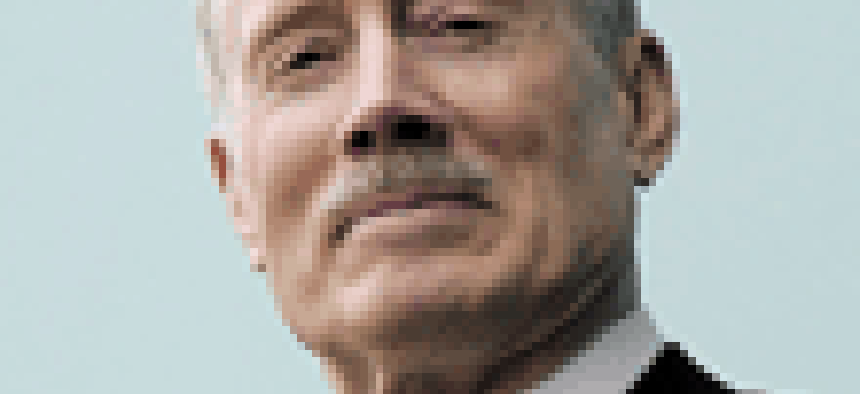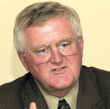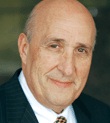Companies consider separation of powers

Ray Oleson still expects his day to start before 5 a.m. after he relinquishes his duties as chief executive officer of SI International Inc. But he also looks forward to losing the heavy burden of related responsibilities he carries on his shoulders.
Ray Oleson still expects his day to start before 5 a.m. after he relinquishes his duties as chief executive officer of SI International Inc. But he also looks forward to losing the heavy burden of related responsibilities he carries on his shoulders.On Sept. 24, S. Bradford Antle, SI International's president and chief operating officer, will assume Oleson's role of CEO, while Oleson, the company founder, keeps his title of chairman of the board."There's already been a lessening of tension in my body," Oleson said. "I'm looser now than I was two months ago before the announcement. It'll take a big responsibility off me and put it on Brad's shoulders."Public companies across all industries increasingly are dividing chairman and CEO responsibilities. With the splitting of roles at SI International, the trend has reached the government IT sector.But how deeply the concept takes root remains to be seen. Most of the companies in the top 25 of Washington Technology's Top 100 have one person who holds both the chairman and CEO positions. Several current and former executives experienced in the federal sector question whether it is necessary to divide responsibilities.[IMGCAP(2)]There are signs that government contractors are open to the idea. In October 2004, SRA International Inc.'s Chairman and CEO Ernst Volgenau gave up the CEO title to company President Renato DiPentima. Volgenau, however, had only filled both the chairman and CEO positions since November 2003, when the company's chairman, William Brehm, retired, after 23 years.Volgenau, who founded SRA 27 years ago, said that he relinquished the CEO position to have more time for his family, charitable work and writing.At the Allied Defense Group Inc. of Vienna, Va., retired Army Gen. J.H. Binford Peay III became chairman of the board, CEO and president in January 2001, but resigned as CEO and president in June 2003. He continues to serve as the company's chairman."With Sarbanes-Oxley, the requirements for board activities today, compliance and disclosure and the need for boards to challenge the [company] management, it's close to a full-time job for both the chairman as well as the CEO," DiPentima said.SCANDALS AND MANDATESThe Sarbanes-Oxley Act is a major driver behind the separation of chairmen and CEOs. The 2002 law, which brought new corporate financial and disclosure rules, came about after a series of big corporate financial scandals, among them Enron Corp., WorldCom Corp., Tyco Corp. and Arthur Andersen LLP."Sarbanes-Oxley has certainly gotten everybody's attention," said David Langstaff, former CEO of Veridian Corp., which was acquired by General Dynamics Corp. in August 2003. Veridian had separate chairman and CEO positions, a structure that was "good common sense" to Langstaff. Since selling Veridian in 2003 -- then No. 22 on the Top 100 list -- Langstaff has served on several boards, including SRA's.In American companies, one person typically has held both positions, unlike in Europe, where the roles are separate in most cases to guarantee better corporate governance. Without a separation, the dual roles can concentrate too much power in the hands of one person, some industry executives said."The most efficient form of government is a benevolent dictator. But the problem is once you establish a dictator, you're never sure if he's going to be benevolent or otherwise," Langstaff said.For Oleson, the change will allow him to shift many of the CEO duties for carrying out Sarbanes-Oxley requirements, as well as investor-related activities, over to Antle, he said. Antle already has been running SI's daily operations."The role of CEO is one of much larger accountability with regard to the day-to-day operations, and that's what Brad will take up fully," Oleson said.Oleson plans to spend more time meeting with senior-level government clients to discuss their priorities, and how SI International can better support their missions, he said. He'll also be doing strategic planning and working on acquisitions.Oleson also will devote more energy to his involvement in some industry boards on which he sits, including the Information Technology Association of America and the Armed Force Communications and Electronic Association, an organization representing government, industry and military professionals in IT, communications and intelligence.Separating the powers of chairman and CEO is a positive trend, Antle said."It makes much greater sense to split those roles, so that you really get a fully engaged board acting the way it should from a shareholders perspective," Antle said. "You get company management focused on company operations, and they come together then at the board."SLOW ADOPTERSCompanies run by their founders dominate the government market. Experts said this is the typical scenario for when a company has one person as its chairman and CEO."A lot of them have a big ego," said John Toups, who was president and CEO of PRC Inc., before Emhart Corp. acquired it in 1987. He now sits on the boards of several public and private companies, including CACI International Inc. of Arlington, Va."Even if they go along with separating [the roles] they may resent it, and they come back to be a problem," he said.There may be a middle ground for companies that do not want to separate their chairman and CEO, said Daniel Young, former president and CEO of Federal Data Corp., which was sold to Northrop Grumman Corp. in 2000. He sits on several boards, including GTSI Corp., a government reseller of computers, software, and networking products. GTSI ranks No. 19 on the Top 100.At GTSI, the same individual, Dendy Young (no relation), is both chairman and CEO. But senior board member John Toups functions almost like a chairman by being designated a lead director. Toups helps Dendy Young manage the board.Toups also is chairman of the company's governance committee, and serves as a go-between when the board wants to communicate with the CEO, except for audit or CEO compensation matters, Daniel Young said.Performance should be the real test of whether to separate the roles of chairman and CEO, he said."If he's doing a good job, and you're confident in him, then you shouldn't take things away from him," Young said. But "when he leaves, I think the board has an obligation to say [they're] going to split these positions."[IMGCAP(3)]Booz Allen Hamilton Inc. has seen chairman and CEOs come and go during its 91-year history, and the company has always had one person fill both posts. It's a tradition that is unlikely to change, said Ralph Shrader, Booz Allen's chairman and CEO."We find that it is virtually necessary to accomplish both the governance mission and the management mission to have one person that has responsibility for both," he said. The privately held McLean, Va., company has had seven chairmen and CEOs, and ranks No. 9 on the Top 100.Some of the impetus for splitting up the roles of chairman and CEO is a knee-jerk reaction to scandals and controversies caused by the dot-com collapse, and it "doesn't necessarily allow the best people to do the job," Shrader said. "It tries to create an artificial barrier."Booz Allen, which offers management consulting and systems integration services, released a report in 2004 on CEO succession. A survey of 2,500 of the largest global companies suggested that separating the roles of chairman and CEO generally reduces returns to investors. In North America, for example, CEOs who are also chairmen deliver annual returns to shareholders 2.6 percentage points higher than CEOs who never hold the chairmanship title, the report found."Our data show companies perform better when you find the right person to do both of those jobs," Shrader said.The report also found that when a former CEO remained chairman while a new CEO stepped in, results for investors generally were worse than if the roles remained combined.But Oleson and Antle aren't worried about this happening at SI International. The pair has worked together for six years, and Oleson has been handing off more work to Antle over the years to prepare him for the CEO position.As evidence, Oleson points to the rise in SI International's stock price since the announcement that Antel would be stepping into the CEO's shoes. Shares rose 9 percent from a closing price of $28.66 July 21, the day before the succession plan was announced, to $31.25 at noon Sept. 6, as Washington Technology was going to print."That bodes well for the careful planning that went into making sure that we communicated [the news] properly to the investment community," Oleson said. "It bodes well to the fact that the investment community has a lot of confidence in Brad."Staff Writer Roseanne Gerin can be reached at rgerin@postnewsweektech.com.




"It bodes well that the investment community has a lot of confidence in Brad Antel." ? Ray Oleson of SI.

"With Sarbanes-Oxley, requirements for board activities, compliance and disclosure and the need for boards to challenge management, it's close to a full-time job for the chairman and CEO." ? Renato DiPentima of SRA.

Ernst Volgenau, who founded SRA 27 years ago, said he relinquished the CEO position to have more time for his family, charitable work and writing.
NEXT STORY: Picture This